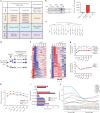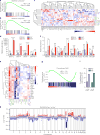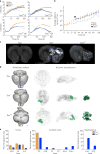Mutant-IDH1-dependent chromatin state reprogramming, reversibility, and persistence
- PMID: 29180699
- PMCID: PMC5769471
- DOI: 10.1038/s41588-017-0001-z
Mutant-IDH1-dependent chromatin state reprogramming, reversibility, and persistence
Abstract
Mutations in IDH1 and IDH2 (encoding isocitrate dehydrogenase 1 and 2) drive the development of gliomas and other human malignancies. Mutant IDH1 induces epigenetic changes that promote tumorigenesis, but the scale and reversibility of these changes are unknown. Here, using human astrocyte and glioma tumorsphere systems, we generate a large-scale atlas of mutant-IDH1-induced epigenomic reprogramming. We characterize the reversibility of the alterations in DNA methylation, the histone landscape, and transcriptional reprogramming that occur following IDH1 mutation. We discover genome-wide coordinate changes in the localization and intensity of multiple histone marks and chromatin states. Mutant IDH1 establishes a CD24+ population with a proliferative advantage and stem-like transcriptional features. Strikingly, prolonged exposure to mutant IDH1 results in irreversible genomic and epigenetic alterations. Together, these observations provide unprecedented high-resolution molecular portraits of mutant-IDH1-dependent epigenomic reprogramming. These findings have substantial implications for understanding of mutant IDH function and for optimizing therapeutic approaches to targeting IDH-mutant tumors.
Conflict of interest statement
The authors declare no competing financial interests.
Figures






References
Publication types
MeSH terms
Substances
Grants and funding
LinkOut - more resources
Full Text Sources
Other Literature Sources
Molecular Biology Databases
Research Materials
Miscellaneous

